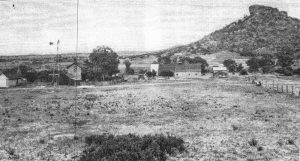From Woodhouses Come Bricks

This photo is the Charles Woodhouse farmstead looking east. The location is right on East Plum Creek where Skelly once was and now Circle K gas station sits on Wolfensberger Road.
Sheffield, England, long a center of heavy industry, was the home of James Woodhouse, born in 1843. There, he worked in a foundry and was a master brickmaker. No shrinking violet, James boxed professionally in the bare-knuckled era. He had 100 fights to his credit and no defeats. Imbued with extraordinary energy, he found time to train horses. Yet, he saw greener pastures in America. He immigrated to Hartford, Connecticut with his English wife Susannah Veil as the U.S. Civil War wound down in 1865.
Five years later found James in Douglas County, where he again took to making bricks on acreage located along lower Indian Creek. His early cabin was not welcomed by local Native Americans. It was said that one in particular had a fascination for Susannah, often following her in the morning. A family diary entry noted that when he refused to stop, “Pop just picked him up and throwed him out the door.” The family feared a reprisal and armed themselves, but the worst thing that happened was that they threw rocks at their cabin door.
By 1873, an undaunted Pop was calling his place the Woodhouse Ranch. He raised cattle and sold butter in Denver for 10 cents a pound. Out of necessity, James became a freight hauler in order to sell his dairy products in Denver. Early on, he would also make runs to Leadville, hauling supplies, including whiskey to the miners.
Early table fare for the Woodhouse family included home-baked bread, salt pork, potatoes, dairy products and jackrabbits. The family was generous, almost to a fault. The key to the house was always hung outside the door and the Woodhouses were perfectly comfortable allowing passing travelers to “make themselves at home.” With that privilege came the obligation to wash the dishes.
Susannah died very early in the marriage of a heart attack. A year later, James wed Anna Jaksch, the daughter of Lake Gulch Austrian immigrant ranchers. Apparently, Anna had a penchant for ranching, and together they were a dynamic couple. In short order, they grew and improved their ranch holdings to more than 2,600 acres “under plow.” They were also in the forefront of the day’s wheat harvesting technology, employing push headers, header barges and threshing machines.
Still, Douglas County history will see the Woodhouse family as brick people both layers and makers. Some of their product was used in the old Douglas County Courthouse, lost to arson in 1978. Later, Woodhouse family members were instrumental in building the DuPont dynamite plant in Louviers, including work on the landmark smokestack that dominated the area for years.
James’ brother, Charles Woodhouse, and family had also come to Castle Rock via Connecticut and homesteaded land that abutted Castle Rock itself. He, too, built a brickmaking kiln right on East Plum Creek, and his mighty, sturdy home had walls 18 inches thick. The family house was located where the Skelly gas station once stood on Wolfensberger before the 1965 flood washed it away. Today, the homesite is occupied by the Circle K gas station and convenience store.
By Joe Gschwendtner; photo courtesy of OUR HERITAGE: People of Douglas County by DCHS